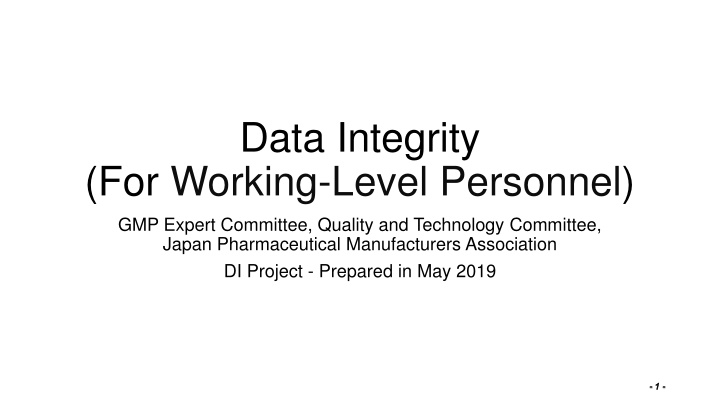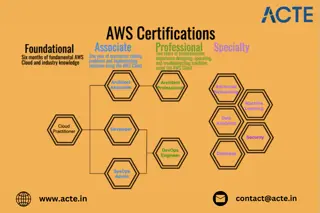
Enhancing Data Integrity for Working-Level Personnel in Pharmaceutical Manufacturing
Discover the importance of data integrity for working-level personnel in the pharmaceutical industry with a focus on ALCOA+ principles, recommended practices, and examples of deviations. Learn how to ensure data is attributable, legible, contemporaneous, original, and accurate according to industry standards.
Download Presentation

Please find below an Image/Link to download the presentation.
The content on the website is provided AS IS for your information and personal use only. It may not be sold, licensed, or shared on other websites without obtaining consent from the author. If you encounter any issues during the download, it is possible that the publisher has removed the file from their server.
You are allowed to download the files provided on this website for personal or commercial use, subject to the condition that they are used lawfully. All files are the property of their respective owners.
The content on the website is provided AS IS for your information and personal use only. It may not be sold, licensed, or shared on other websites without obtaining consent from the author.
E N D
Presentation Transcript
Data Integrity (For Working-Level Personnel) GMP Expert Committee, Quality and Technology Committee, Japan Pharmaceutical Manufacturers Association DI Project - Prepared in May 2019 - 1 -
Table of Contents (Content for Working-Level Personnel) Data Integrity - Why must we comply with this? What is ALCOA +? Recommended practices / inadvisable practices Examples of DI-related deviations (from FDA warning letter) (Appendix) Glossary (from PIC/S DI guidance 13. Definitions) - 2 -
Table of Contents (Content for Working-Level Personnel) Data Integrity - Why must we comply with this? What is ALCOA +? Recommended practices / inadvisable practices Examples of DI-related deviations (from FDA warning letter) (Appendix) Glossary (from PIC/S DI guidance 13. Definitions) - 3 -
What is ALCOA+? Basic principles of data integrity, applicable to both paper and electronic systems. ALCOA is an acronym that stands for the following. A: Attributable L: Legible C: Contemporaneous O: Original A: Accurate Attributable Available A Legible Enduring L + ALCOA + includes the following in addition to ALCOA. C: Complete C: Consistent E: Enduring A: Available Contemporaneous C Consistent O A Complete Original Accurate - 4 -
A: Attributable It should be possible to identify the individual who performed the recorded task. The need to document who performed the task / function, is in part to demonstrate that the function was performed by trained and qualified personnel. This applies to changes made to records as well: corrections, deletions, changes, etc. A L C + O A Make it possible to trace the date and author (or originator). Create records that ensure the traceability of the work performed. Use registered signatures and seals for records. - 5 -
L: Legible All records must be legible the information must be readable in order for it to be of any use. This applies to all information that would be required to be considered Complete, including all original records or entries. Where the dynamic nature of electronic data (the ability to search, query, trend, etc) is important to the content and meaning of the record, the ability to interact with the data using a suitable application is important to the availability of the record. A L C + O A Make records legibly and accurately. Make records that can be understood correctly and easily. - 6 -
C: Contemporaneous A The evidence of actions, events or decisions should be recorded as they take place. This documentation should serve as an accurate attestation of what was done, or what was decided and why, i.e. what influenced the decision at that time. L C + O A Make records at the same time the operation is performed. - 7 -
O: Original A The original record can be described as the first- capture of information, whether recorded on paper (static) or electronically depending on the complexity of the system). Information that is originally captured in a dynamic state should remain available in that state. L C + (usually dynamic, O A Do not enter results of implementation in record forms other than hose officially approved. Do not use sticky notes or memo paper as part of records. Do not use personal notebooks for recording data or making calculations. - 8 -
A: Accurate Ensuring results and records are accurate is achieved through many elements of a robust Pharmaceutical Quality Management System. This can be comprised of: equipment-related factors such as qualification, calibration, maintenance and computer validation. policies and procedures to control actions and behaviours, including data review procedures to verify adherence to procedural requirements deviation management including root cause analysis, impact assessments and CAPA trained and qualified personnel who understand the importance of following established procedures and documenting their actions and decisions. A L C + O A - 9 -
A: Accurate (continued) Together, these elements aim to ensure the accuracy of information, including scientific data, that is used to make critical decisions about the quality of products. A L C + O A Prepare the written procedures, perform the operations in accordance with these, and make records. Strictly reject dishonest practices related to documents and records (falsification, tampering, etc.) - 10 -
C: Complete All information that would be critical to recreating an event is important when trying to understand the event. The level of detail required for an information set to be considered complete would depend on the criticality of the information. A complete record of data generated electronically includes relevant metadata. When electronic records are integrated from a computerized system to another system (i.e., when records are not maintained in the original system), transfer or archive meta data (including audit trails and electronic signatures) with the electronic records. A L C + O A - 11 -
C: Consistent A Good Documentation Practices should be applied throughout any exception, including deviations that may occur during the process. This includes capturing all changes made to data. L C process, without + O A Apply good data management practice to all GMP documents and records. Records include electronic records and electronic signatures. - 12 -
E: Enduring A Part of ensuring records are available is making sure they exist for the entire period during which they might be needed. This means they need to remain intact and indelible/durable record. L C + accessible as an O A Make paper records in permanent ink. Store electronic records by secure and validated processes. Hold documents intact for the duration of the retention period, based on the lifecycle of such documents. - 13 -
A: Available Records must be available for review at any time during the required retention period, accessible in a readable format to all applicable personnel who are responsible for their review whether for routine release decisions, investigations, trending, annual reports, audits or inspections. A L C + O A Store batch records and other records supporting the batch quality in a secure and reliable manner so as to be retrievable within a specified period of time and to allow for complete reconstruction of batch history. If a computerized system is used, this should be guaranteed at the time of system update. - 14 -
Table of Contents (Content for Working-Level Personnel) Data Integrity - Why must we comply with this? What is ALCOA +? Recommended practices / inadvisable practices Examples of DI-related deviations (from FDA warning letter) (Appendix) Glossary (from PIC/S DI guidance 13. Definitions) - 15 -
Key points of data integrity, specific to paper systems (1) Recommended practices Inadvisable practices Procedures are not specified for the generation, distribution and control of original paper record template. Procedures outlining good documentation practices and arrangements for document control should be available within the QMS. Records may be falsified if templates are not controlled! An obsolete version of record template may be used if versions and issuance of templates are not controlled! Can the contemporaneousness of records be guaranteed if data are recorded on a template other than the one specified? - Generation , distribution and control of templates used to record data - Control procedures for written operating procedures and paper record sheets, etc. - 16 -
Key points of data integrity, specific to paper systems (2) Recommended practices Inadvisable practices No method for reviewing and controlling various records is not specified. (Continued) Procedures outlining good documentation practices and arrangements for document control should be available within the QMS (Continued) Incorrect data may be accepted by QA owing to improper review of records! It may become impossible to confirm the traceability of paper records printed out directly from the electronic system (e.g., balance, pH meter)! Can the integrity of various stored records be guaranteed? - How completed documents are routinely reviewed for accuracy, authenticity and completeness; - Storage method for records - 17 -
Key points of data integrity, for computerized systems (1) Recommended practices Inadvisable practices No computerized system qualification, validation, or periodic system evaluation is performed. Check items related to data management throughout the data lifecycle to ensure data integrity of the computerized system. The computerized system is not sufficiently visualized, so you may overlook a problem in the system! In addition, unvalidated systems may have significant data integrity vulnerabilities! Failure to update the system may adversely affect data integrity! - Qualification and validation of computerized systems - Periodic system evaluation of computerized systems - 18 -
Key points of data integrity, for computerized systems (2) Recommended practices Inadvisable practices Check items related to data management throughout the data lifecycle to ensure data integrity of the computerized system. (Continued) Data transfer between computerized systems has not been evaluated. If there is any problem with the interface between systems, data may be lost or changed by mistake or fraudulently rewritten during the transfer process! - Assessment of data transfer between systems Login IDs and PWs for the computerized systems are shared among persons in charge. Anyone can modify and delete data! You cannot tell who performed the task! - System security for computerized systems - 19 -
Key points of data integrity, for computerized systems (3) Recommended practices Inadvisable practices Check items related to data management throughout the data lifecycle to ensure data integrity of the computerized system. (Continued) Continuing to use an old computerized system without an electronic audit trail function Can you assure the data integrity? These kinds of systems are not able to keep the history of data change or deletion. Audit trail for computerized systems Manual analysis and reanalysis of test results have not been performed according to approved and controlled procedures. The data obtained may not be reliable because it cannot be guaranteed that the test results were processed in a correct manner! - Data acquisition and entry; data review; storage, archiving, and disposal of electronic data - 20 -
Key points of data integrity, common to all types of records (1) Recommended practices Inadvisable practices Actual samples are used in system suitability testing, trial injection, and equilibration operations. It may be assumed that actual samples were used in trial injection and equilibration operations for the purpose of obtaining specific results (as a means of hiding inappropriate test results)! Standard samples or other standard solutions are used in system suitability tests Personnel are trained to enable them to review and verify data integrity Data are reviewed by personnel with inadequate training and experience in audit trails. The integrity of data reviewed as such may not be fully assured! - 21 -
Key points of data integrity, common to all types of records (2) Recommended practices Inadvisable practices Raw materials are purchased from manufacturers for whom no on-site audit has been performed. The data provided by the manufacturer may be unreliable because it has never been audited from the standpoint of data integrity! Periodic risk reviews are performed for the supply chain, and necessary data integrity control measures are assessed. GMP violations involving data integrity that were found during regulatory inspections were handled by personnel with limited knowledge of data integrity, who only addressed the findings themselves. Because the nature and root cause of data integrity failure cannot be completely extracted by such personnel, it may be difficult to plan improvement measures that are satisfactory to the regulatory authorities! The scope of errors in data recording and reporting are comprehensively investigated. - 22 -
Key points of data integrity, common to all types of records (3) Recommended practices Inadvisable practices Changes in data Are authorized and managed according to approved procedures. The original data are retained in the original format. All changes or corrections to original data are documented, and these are reviewed and approved by a designated competent person who has received appropriate training. There is no procedure for entering, changing, correcting and reviewing important data. If it is not known who entered what and when (Attributability), you cannot guarantee that it is the official data! Data that are incorrectly entered may be approved as they are! Data might be fraudulently changed! => Data falsification! - 23 -
Table of Contents (Content for Working-Level Personnel) Data Integrity - Why must we comply with this? What is ALCOA +? Recommended practices / inadvisable practices Examples of DI-related deviations (from FDA warning letters) (Appendix) Glossary (from PIC/S DI guidance 13. Definitions) - 24 -
Warning letter example (1) November 2017, German pharmaceutical company Your firm failed to establish an adequate quality control unit with the responsibility and authority to approve or reject all components, drug product containers, closures, in-process materials, packaging materials, labeling, and drug products, and that approves or rejects all procedures or specifications impacting on the identity, strength, quality, and purity of the drug product (21 CFR 211.22(a) and (c)). Observed discarded original personnel training records.. Observed discarded forms used to document and set inspection parameters for your automated tablet visual inspection machinery. These parameters are used to accept or reject tablets. Your firm failed to ensure that laboratory records included complete data derived from all tests necessary to assure compliance with established specifications and standards (21 CFR 211.194(a)). Observed unreported data from in-process tablet weight checks. You programmed your in-process weight checker not to report values that varied more than (b)(4)% from the tablet target weight. - 25 -
Warning letter example (2) April 2017, Chinese pharmaceutical company Failure to prevent unauthorized access or changes to data, and failure to provide adequate controls to prevent omission of data. Your analysts manipulated the date/time settings on your high performance liquid chromatography (HPLC) systems. Your analysts admitted to setting the clock back and repeating analyses for undocumented reasons. Initial sample results were overwritten or deleted, and unavailable for our investigators review. Your quality control analysts used a shared login account to access HPLC systems. This shared account allowed analysts, without traceability, to change the date/time settings of the computer, to modify file names, and to delete original HPLC data. your firm s HPLC systems used for API testing had the audit trail feature disabled, although all (b)(4) had audit trail functionality. Failure to maintain complete data derived from all laboratory tests conducted to ensure compliance with established specifications and standards. HPLC chromatograms were deleted and not available for our investigators review Found a recurring practice of re-testing samples until acceptable results were obtained. The initial test result was invalidated. Only the results of the second analysis were used for batch disposition, without documented justification or investigation. - 26 -
Warning letter example (3) October 2018, South Korean pharmaceutical company Your firm failed to ensure that laboratory records included complete data derived from all tests necessary to assure compliance with established specifications and standards (21 CFR 211.194(a)). Control of test records at QC laboratory was insufficient. Observed a quality control analyst and laboratory team leader signing and backdating a test record. Also observed an analyst recording microbiological test results from environmental monitoring settling plates before reading the plates. Your firm failed to exercise appropriate controls over computer or related systems to assure that only authorized personnel institute changes in master production and control records, or other records (21 CFR 211.68(b)). Three of your quality control team leaders had administrator privileges within your HPLC computerized laboratory software system. Because they review and approve CGMP data, their access level should preclude file deletion or modification. In addition, two of your laboratory software systems had unlocked time and date functions, which allowed users to change the recorded dates and times of analyses. - 27 -
Table of Contents (Content for Working-Level Personnel) Data Integrity - Why must we comply with this? What is ALCOA +? Recommended practices / inadvisable practices Examples of DI-related deviations (from FDA warning letter) (Appendix) Glossary (from PIC/S DI guidance 13. Definitions) - 28 -
What is Data Integrity? The extent to which all data are complete, consistent and accurate throughout the data lifecycle. Data should follow the principles of ALCOA +. Data integrity principles apply equally to paper, computerized and hybrid systems and should not limit the development or adoption of new concepts or technologies. Good Documentation Practices (GDocPs) are the cornerstone of ensuring data integrity and are a fundamental part of a well-designed pharmaceutical quality system. Management should be aware of legal and moral obligations (i.e., responsibilities and authorities) to prevent data integrity failures and detect them as they occur. If a data integrity failure is found, it should be handled as a deviation based on the pharmaceutical quality system. - 29 -
What is data governance? The sum total of arrangements to ensure that data, irrespective of the format in which it is generated, is recorded, processed, retained and used to ensure a complete, consistent and accurate record throughout the data lifecycle. Data governance is the sum total of arrangements that provide assurance of data quality. The data governance system should be integrated with the pharmaceutical quality system to ensure control according to the principles of quality risk management in the data lifecycle. (implementation of systems and procedures to minimize potential risks to data integrity) The organizational arrangements for data governance should be documented and periodically reviewed within the pharmaceutical quality system. An effective risk management approach to data governance takes into account the criticality and risk of the data. - 30 -
What are data? Facts, figures and statistics collected together for reference or analysis. What is the data lifecycle? All phases in the life of the data (including raw data) from initial generation and recording through processing (including transformation or migration), use, data retention, archive / retrieval and destruction. - 31 -
What are meta data? Data that describes the attributes of other data, and provides context and meaning. An audit trail is a type of meta data. Data should include all of original data and meta data, including audit trails, and should be stored using a secure and validated process. A complete record of electronically generated data should include relevant meta data. An example of meta data): As a result (unit: mg) of from the weighing of sodium chloride of batch No. 1234 done by Mr. D.I. on / / (Month/Day/Year), a datum of "sodium chloride batch No. 1234, 3.5 mg, D.I. / / , is obtained; in this case, the results other than "3.5" are meta data. - 32 -
What is an audit trail? GMP/GDP audit trails are metadata that are a record of GMP/GDP critical information (for example the change or deletion of GMP/GDP relevant data), which permit the reconstruction of GMP/GDP activities. The company should endeavor to purchase and, thereafter, upgrade software containing an electronic audit trail function. If the system does not have an audit trail function, other methods to verify the accuracy of the data should be implemented (e.g. control procedures, secondary checks). The audit trail function should always be available and locked. Limit the audit trail function so that the user cannot modify it. If the audit trail function is disabled by the administrator, an entry indicating that the function is disabled is automatically entered in the audit trail. Include the following parameters in the audit trail: Person making the change, details of the change (values before and after the change), date and time of the change, reason for the change, and name of approver. It should be possible to print and provide an electronic copy of the audit trail. - 33 -
What is an audit trail? (Continued) GMP/GDP audit trails are metadata that are a record of GMP/GDP critical information (for example the change or deletion of GMP/GDP relevant data), which permit the reconstruction of GMP/GDP activities. Document (1) the degree of importance for each data and (2) operations done that need to be kept as audit trails. It should be configured to record all manually initiated processes related to critical data. Allow for the reconstruction of the course of events related to creation, modification or deletion of electronic records. Procedures describing the audit trail review policy and process should be established in accordance with the risk management policy. Review of audit trails should be performed periodically with review of data. Critical audit trails for each operation should be reviewed independently of all other records related to the operation and be done prior to reviewing the completion of the operation (independently reviewed prior to batch release) Review should be performed by the department in charge of preparation and verified by the quality unit if necessary. - 34 -
What is archiving? Long-term, permanent retention of completed data and relevant meta data in its final form for the purposes of reconstruction of process or activity Obsolete master documents and files should be archived and access restricted. Systems describing archiving steps are required. (identification of depository, list of records for each depository, storage periods, storage places, etc.) Access to archived documents should be restricted to authorized personnel. Store the data securely in a place separate from the storage place for backup data and original data. Paper records: Store in an easily traceable and retrievable form in a secure location such that damage and loss are prevented and durability is ensured throughout the retention period. (Protection from fire, liquid, rodents, humidity, etc.) Electronic records: Ensure that, when software is updated, archived data are readable by the new software. The records should be stored periodically according to the procedure. A restoration procedure is required. - 35 -
What is backup? A copy of current (editable) data, metadata and system configuration settings (e.g., variable settings which relate to an analytical run) maintained for the purpose of disaster recovery. Backup should be subjected to an appropriate level of control, equivalent to that for the original data. (To prevent unauthorized access, data change or deletion, and falsification) Maintain appropriate software and hardware to access backups. Backups should be stored in a location physically separate from the original data. - 36 -






















